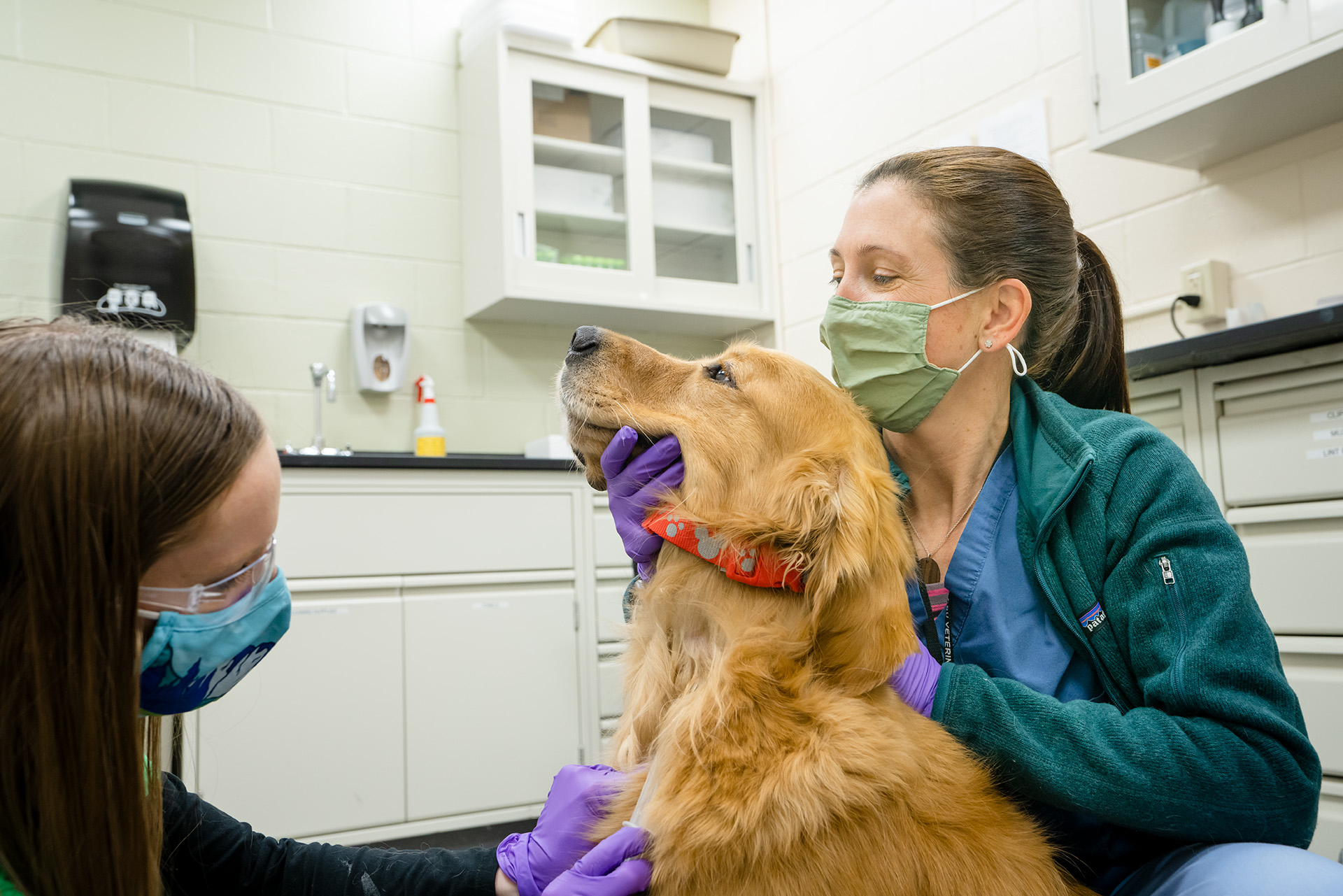
By Lisa Mulligan
A groundbreaking new study is underway at the James L. Voss Veterinary Teaching Hospital to understand the response to three different medications in the treatment of canine cognitive dysfunction syndrome (CCDS) in aging dogs, with the long-term hope of advancing Alzheimer’s disease treatments in humans.
The study, Investigating the effect of trazodone, rapamycin, and cannabidiol on cognitive dysfunction in dogs, is led by principal investigators Dr. Stephanie McGrath and Julie Moreno, Ph.D., and the researchers are looking for people who would like to have their dogs evaluated for enrollment in the study.
Dementia is a problem for aging humans and dogs alike. As the proportion of older Americans relative to the overall population in the U.S. continues to rise, Alzheimer’s disease and other forms of dementia are becoming increasingly frequent causes of disability and death. The likelihood of Alzheimer’s disease increases with age, affecting 5.3% of people between the ages of 65-74, rising to 13.8% in 75- to 84-year-olds, and ballooning to 34.6% for those over the age of 85. To further compound the problem, the number of Americans over age 65 is projected to increase from 58 million in 2021 to 88 million by 2050.
Given the long duration of the disease, the socioeconomic impact is immense. The loss of independence and the requirements for care both from family members and from nursing facilities is associated with tremendous costs, in addition to the steep emotional toll the disease ensues. Despite this impact, treatments have only been developed to reduce symptoms, but not stop the disease progression. Treatments available include monoclonal antibodies, supplements, and lifestyle interventions, but these options have only shown modest and temporary improvement of symptoms at best.
Canine cognitive dysfunction syndrome
One of the challenges to discovering a treatment for Alzheimer’s disease is identifying a good model for research, which is where canine cognitive dysfunction syndrome comes in. CCDS is a neurodegenerative disease affecting dogs with many similarities to Alzheimer’s disease. It affects 14%-35% of dogs over the age of 8, and that percentage continues to increase with advancing age, with one study reporting that 68% of dogs 15 to 16 years old are affected. Signs of CCDS include changes in behavior, like disorientation, irritability, changes in sleep cycles, house soiling, and decreased activity. These behaviors can impact quality of life of both the dog and the owner, and given the frequency of the disease, it is an important target for research in companion animals.
The disease also has a great deal in common with Alzheimer’s disease in humans, even at the biological level. The brains in Alzheimer’s disease patients classically have deposits of beta-amyloid protein known as plaques, and neurofibrillary tangles marked by hyperphosphorylated tau proteins; observations also made in dogs with CCDS. Critically, dogs typically share a home closely with their humans and are subject to many of the same environmental exposures.
TRAC study
McGrath, a veterinary neurologist at the Veterinary Teaching Hospital, and Moreno, an assistant professor in the Department of Environmental and Radiological Health Sciences, are partnering to tackle these complex diseases.
“The discovery of therapeutics for diseases like Alzheimer’s disease is essential but extremely difficult as we are unable to fully model it appropriately in the basic research laboratory,” Moreno said. “However, when collaborations like ours exist, we can take findings from a mouse or a worm and apply them to a dog with clinical disease. The advantage of dogs is that they have a naturally occurring form of Alzheimer’s disease that is similar to the human form.”
For their study, 48 dogs showing signs of canine cognitive dysfunction syndrome will be recruited. They will undergo an extensive battery of neurological exams, laboratory tests, and radiological imaging, and will then be treated with either cannabidiol, rapamycin, trazodone or placebo. Each of the study medications has been shown to have some action against one of the neural pathways known to be involved in CCDS, either in vitro or in laboratory animal models. The dogs will receive one medication twice per day and another given once per week at home, and their owners will closely observe their behaviors. They will return to the Veterinary Teaching Hospital for follow-up testing every 12 weeks for two years.
“Our hope is that by studying the process of aging and dementia in dogs, we can start finding ways to prevent or even reverse some of the devastating changes that occur in older animals,” McGrath said. “The ultimate goal is not only to help our furry companions, but as this disease in dogs closely mimics human dementias, including Alzheimer’s disease, to also set the foundation for future success in dementia research in humans.”
If you are interested in having your dog evaluated for enrollment in the study, email csuneurotrials@colostate.edu or call (970) 297-4405. To support the neurology and neurosurgery service at the James L. Voss Veterinary Teaching Hospital, including research and clinical trials like this study, give to the Neurology STAND fund.